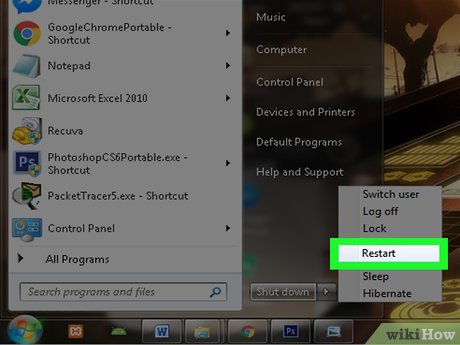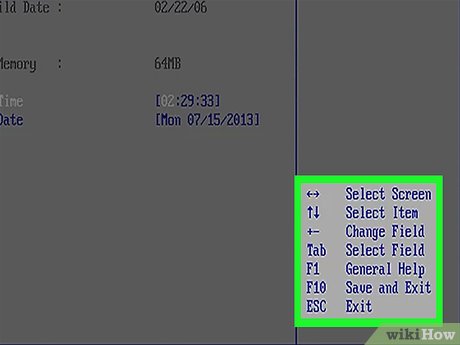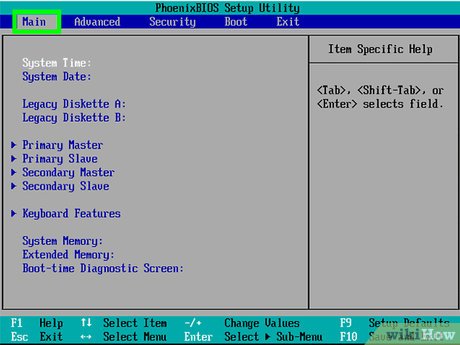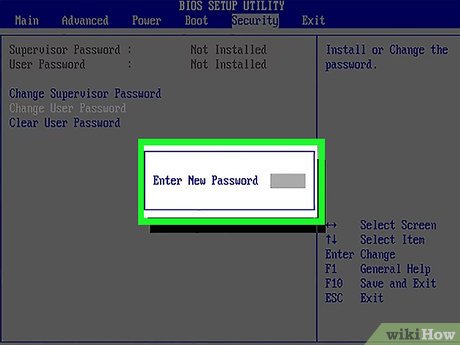How to Change Computer BIOS Settings
Part 1 of 2:
Entering the BIOS
-
 Restart your computer. Open Start, click the power icon
Restart your computer. Open Start, click the power icon , and click Restart.
, and click Restart.
- If your computer is locked, click the lock screen, then click the power icon in the bottom-right corner of the screen and click Restart.
- If your computer is already off, press your computer's "On" switch.
-
 Wait for the computer's first startup screen to appear. Once the startup screen appears, you'll have a very limited window in which you can press the setup key.
Wait for the computer's first startup screen to appear. Once the startup screen appears, you'll have a very limited window in which you can press the setup key.- It's best to start pressing the setup key as soon as the computer begins to restart.
- If you see "Press [key] to enter setup" or something similar flash across the bottom of the screen and then disappear, you'll need to restart and try again.
-
 Press and hold Del or F2 to enter setup. The key you're prompted to press might also be different; if so, use that key instead.
Press and hold Del or F2 to enter setup. The key you're prompted to press might also be different; if so, use that key instead.- You'll typically use the "F" keys to access the BIOS. These are at the top of your keyboard, though you may have to locate and hold the Fn key while pressing the proper "F" key.
- You can look at your computer model's manual or online support page to confirm your computer's BIOS key.
-
 Wait for your BIOS to load. After successfully hitting the setup key, the BIOS will load. This should only take a few moments. When the loading is complete, you will be taken to the BIOS settings menu.
Wait for your BIOS to load. After successfully hitting the setup key, the BIOS will load. This should only take a few moments. When the loading is complete, you will be taken to the BIOS settings menu.
Part 2 of 2:
Adjust Settings
-
 Familiarize yourself with the BIOS controls. Since BIOS menus don't support mouse input, you'll need to use the arrow keys and other computer-specific keys to navigate the BIOS. You can usually find a list of controls in the bottom-right corner of the BIOS homepage.
Familiarize yourself with the BIOS controls. Since BIOS menus don't support mouse input, you'll need to use the arrow keys and other computer-specific keys to navigate the BIOS. You can usually find a list of controls in the bottom-right corner of the BIOS homepage. -
 Change your settings carefully. When adjusting settings in your BIOS, be sure that you certain what the settings will affect. Changing settings incorrectly can lead to system or hardware failure.
Change your settings carefully. When adjusting settings in your BIOS, be sure that you certain what the settings will affect. Changing settings incorrectly can lead to system or hardware failure.- If you don't know what you want to change coming into the BIOS, you probably shouldn't change anything.
-
 Change the boot order. If you want to change what device to boot from, enter the Boot menu. From here, you can designate which device the computer will attempt to boot from first. This is useful for booting from a disc or flash drive to install or repair an operating system.
Change the boot order. If you want to change what device to boot from, enter the Boot menu. From here, you can designate which device the computer will attempt to boot from first. This is useful for booting from a disc or flash drive to install or repair an operating system.- You'll typically use the arrow keys to go over to the Boot tab to start this process.
-
 Create a BIOS password. You can create a password that will lock the computer from booting unless the correct password is entered.
Create a BIOS password. You can create a password that will lock the computer from booting unless the correct password is entered. -
 Change your date and time. Your BIOS's clock will dictate your Windows clock. If you replace your computer's battery, your BIOS clock will most likely be reset.
Change your date and time. Your BIOS's clock will dictate your Windows clock. If you replace your computer's battery, your BIOS clock will most likely be reset. -
 Change fan speeds and system voltages. These options are for advanced users only. In this menu, you can overclock your CPU, potentially allowing for higher performance. This should be performed only if you are comfortable with your computer's hardware.
Change fan speeds and system voltages. These options are for advanced users only. In this menu, you can overclock your CPU, potentially allowing for higher performance. This should be performed only if you are comfortable with your computer's hardware. -
 Save and exit. When you are finished adjusting your settings, you will need to save and exit by using your BIOS' "Save and Exit" key in order for your changes to take effect. When you save and restart, your computer will reboot with the new settings.
Save and exit. When you are finished adjusting your settings, you will need to save and exit by using your BIOS' "Save and Exit" key in order for your changes to take effect. When you save and restart, your computer will reboot with the new settings.- Check the BIOS key legend to see which key is the "Save and Exit" key.
4.5 ★ | 2 Vote
You should read it
- What is CMOS and what is it used for?
- How to Enter BIOS
- Instructions for entering BIOS on different computers
- Understanding BIOS: An Indispensable Component of a Computer
- How to set up BIOS to boot from USB / CD / DVD, external hard drive
- BIOS - Basic information for beginners
- 5 tips for using BIOS to help you master your computer - What is BIOS and how to use BIOS
- Self-assemble computers, build desktops (P3): BIOS settings
May be interested
- The fastest way to enter Windows 11 BIOS
 while using a windows 11 computer, when making some changes to hardware settings or fixing system errors, you will need to go into the bios to do so. for professionals, it is certainly no stranger, but if you do not know how to enter bios win 11, please follow the instructions below.
while using a windows 11 computer, when making some changes to hardware settings or fixing system errors, you will need to go into the bios to do so. for professionals, it is certainly no stranger, but if you do not know how to enter bios win 11, please follow the instructions below. - BIOS - Basic information for beginners
 probably not very often when you think about computer troubleshooting tools as long as the trouble happens to you. your computer has its own troubleshooting center, which is bios (basic i / o system). without the instruction set from the bios, your operating system will not boot.
probably not very often when you think about computer troubleshooting tools as long as the trouble happens to you. your computer has its own troubleshooting center, which is bios (basic i / o system). without the instruction set from the bios, your operating system will not boot. - 5 tips for using BIOS to help you master your computer - What is BIOS and how to use BIOS
 most computer users usually don't care much about bios. however when the problem occurs, you need to tweak a setting and don't know what to do. you will wonder what is bios? really need to know about it?
most computer users usually don't care much about bios. however when the problem occurs, you need to tweak a setting and don't know what to do. you will wonder what is bios? really need to know about it? - Self-assemble computers, build desktops (P3): BIOS settings
 bios stands for basic input-output system (basic input-output system). it is a small program that is stored on a small memory chip in the motherboard and runs on your computer before the operating system works, thereby helping you to set up everything and allowing changes to the settings. basic of the system.
bios stands for basic input-output system (basic input-output system). it is a small program that is stored on a small memory chip in the motherboard and runs on your computer before the operating system works, thereby helping you to set up everything and allowing changes to the settings. basic of the system. - Things to note when using UEFI instead of BIOS
 new windows 8 computers do not use the traditional bios, but instead are uefi firmware like the macs that had been years ago. how you can perform common system tasks has changed.
new windows 8 computers do not use the traditional bios, but instead are uefi firmware like the macs that had been years ago. how you can perform common system tasks has changed. - Shortcuts to BIOS of Asus, Dell, Hp, Sony Vaio, Acer, Lenovo Laptops
 keyboard shortcuts to bios of asus, dell, hp, sony vaio, acer, lenovo laptop. the settings in the bios of computer lines are very important, it helps you to see the configuration, settings and fix the computer. depending on the model, the shortcut keys to access the bios are different.
keyboard shortcuts to bios of asus, dell, hp, sony vaio, acer, lenovo laptop. the settings in the bios of computer lines are very important, it helps you to see the configuration, settings and fix the computer. depending on the model, the shortcut keys to access the bios are different. - How to Check BIOS Version
 a computer's bios is the firmware interface between a computer's hardware and its operating system. like any software, the bios can be updated. knowing your computer's bios version can tell you if you have the most up-to-date version of...
a computer's bios is the firmware interface between a computer's hardware and its operating system. like any software, the bios can be updated. knowing your computer's bios version can tell you if you have the most up-to-date version of... - How to Update Your Computer's BIOS
 this wikihow teaches you how to update the bios software for a windows computer. keep in mind that your bios rarely needs updating, and updating the bios incorrectly can render your computer completely inoperable. mac computers do not use...
this wikihow teaches you how to update the bios software for a windows computer. keep in mind that your bios rarely needs updating, and updating the bios incorrectly can render your computer completely inoperable. mac computers do not use... - Display BIOS information on Windows 10 using Command Prompt
 on windows 10 you can view bios information using the command command. if you want to print or just want to see how much your bios version is, there is no need to install any 3rd party tool or use the traditional method of rebooting the computer.
on windows 10 you can view bios information using the command command. if you want to print or just want to see how much your bios version is, there is no need to install any 3rd party tool or use the traditional method of rebooting the computer. - Should I update the BIOS? 5 important notes when updating BIOS
 answer the question whether to update (update/upgrade) bios for the computer or not, the most detailed bios updates and notes.
answer the question whether to update (update/upgrade) bios for the computer or not, the most detailed bios updates and notes.

















 How to Clean Up a Slow Performing Computer
How to Clean Up a Slow Performing Computer How to Reset Your BIOS
How to Reset Your BIOS How to Fix a File Corruption Error
How to Fix a File Corruption Error How to Recover Data with MediaRECOVER for Windows
How to Recover Data with MediaRECOVER for Windows How to Fix a Malware Infection on Your Computer
How to Fix a Malware Infection on Your Computer How to Recover Deleted Files on Copy
How to Recover Deleted Files on Copy